Category: Møte
MAX IV opens for general users
Opportunity: Check out what MAX IV («Max four») can do for your research — attend the lecture by Stephen Molloy this Friday (May 24), Auditorium B (Allegaten 66) at 14.15!
MAX IV Laboratory is a Swedish national laboratory providing scientists with the most brilliant X-rays for research, located in Lund and easily accessible from Bergen via Copenhagen. As indicated by the name, this is the fourth generation of synchrotron radiation facilities in Lund, Sweden, and it also represents the fourth generation of technology for producing extremely brilliant, collimated and coherent X-rays by way of electron storage rings.
Researchers from all over the world come to MAX IV to perform experiments using synchrotron x-rays at various beamline experimental stations that operate 24 hours a day, six days a week. Each experimental station is designed and specialized for a certain type of experiment. A “user” is someone who has been granted access (“beamtime”) to use a beamline at a synchrotron facility through a peer-reviewed proposal system. Access is granted based on academic merits and free of charge, under the condition that all results are timely disseminated into the academic public. The first upcoming deadline for general users to apply for beam time is 17 September 2019. There are at present 16 beamlines funded for research covering a wide range of scientific areas and photon energy ranges. An overview of beamlines and techniques that are available to general users may be found here. The beamline portfolio is expected to continue to grow up to around 30 beamlines in 2026.
When completed, it is expected that MAX IV Laboratory will receive more than 2000 individual researchers annually to carry out experiments in a variety of disciplines including surface science, semiconductor physics, materials science, atomic and molecular physics, chemistry, biology, cultural heritage, and medicine. Their research will be offered world-class performance beamlines at the MAX IV Laboratory. The synchrotron radiation from the two storage rings covers the wavelength range from the far infrared through the UV, VUV, soft x-ray up to the hard x-ray range using radiation from bending magnets or insertion devices. Among the techniques used at these beamlines are: VUV and soft x-ray electron spectroscopy and microscopy, soft x-ray magnetic circular dichroism, x-ray fluorescence, x-ray absorption spectroscopy and different x-ray diffraction and scattering techniques.
Torgils presented the Nobel Prize of Chemistry
The traditional annual Nobel Prize Party, organized by the Bergen chapter for the Norwegian Chemical Society, was very successfully held last Friday.
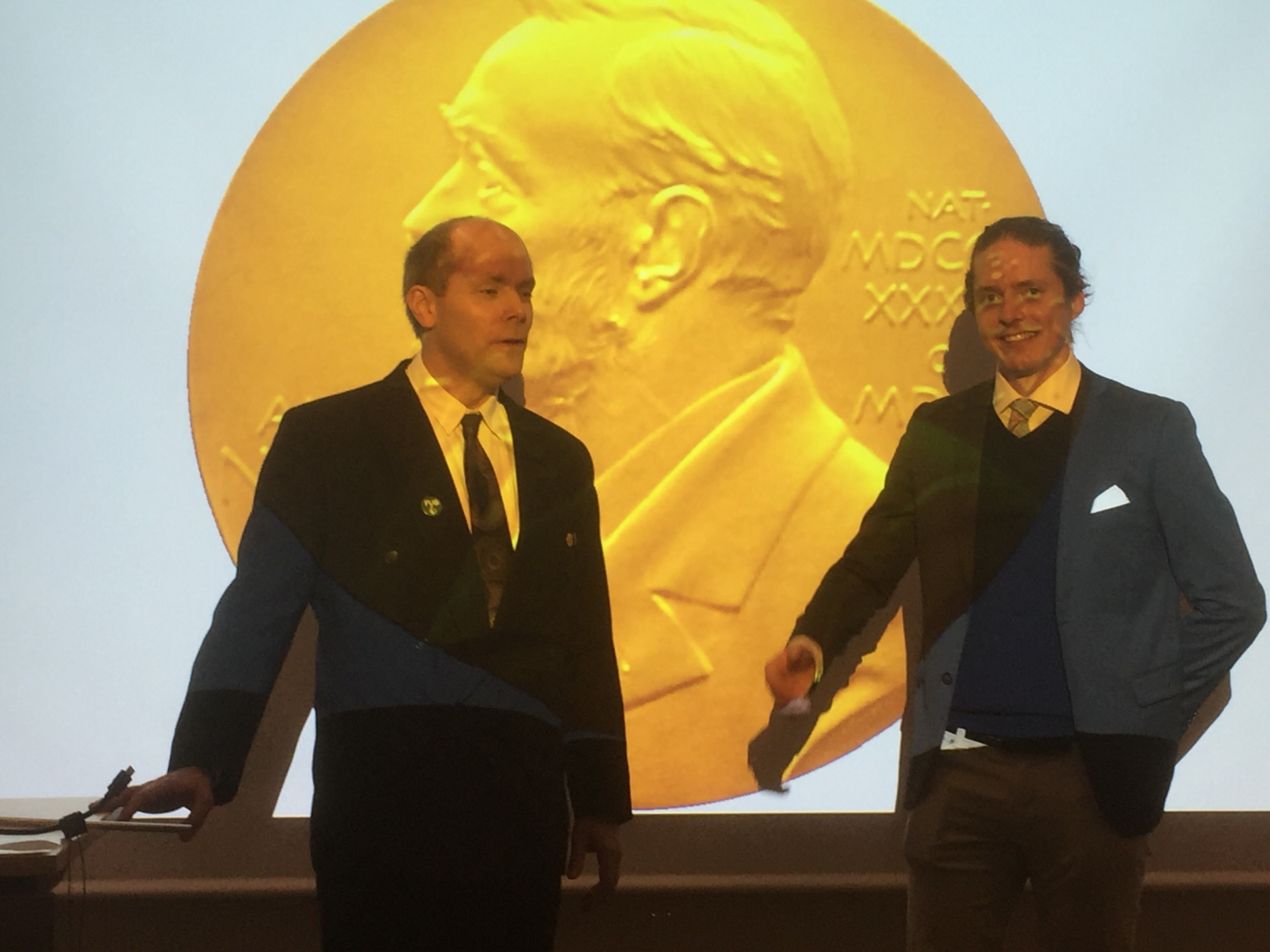 This year the Nobel Prize in Chemistry was divided, one half awarded to Frances H. Arnold «for the directed evolution of enzymes», the other half jointly to George P. Smith and Sir Gregory P. Winter «for the phage display of peptides and antibodies.» Prof. Torgils Fossen, gave a very well-prepared and insightful lecture on the subject of this year’s Nobel prize. After the lecture it was party time with seafood, refreshments and good company counting chemists at all ages from bachelor and upward.
This year the Nobel Prize in Chemistry was divided, one half awarded to Frances H. Arnold «for the directed evolution of enzymes», the other half jointly to George P. Smith and Sir Gregory P. Winter «for the phage display of peptides and antibodies.» Prof. Torgils Fossen, gave a very well-prepared and insightful lecture on the subject of this year’s Nobel prize. After the lecture it was party time with seafood, refreshments and good company counting chemists at all ages from bachelor and upward.
In case you missed the event, be on alert next year when it comes around!
Guest lecture in the BIO building this Friday
Time and place: Friday June 15th at 13:15 in K3@BIO.
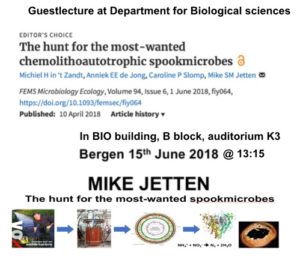
Mike Jetten and his team have provided significant discoveries about the role of anaerobic bacteria in the global nitrogen cycle (anammox) and nitrate-dependent methane oxidation.The anammox bacteria can convert nitrogen compounds into dinitrogen gas without oxygen.This process is highly beneficial to the development of sustainable waste water treatment. Anammox has therefore been implemented in sewage treatments plants worldwide.
The LKS Symposium – A great success
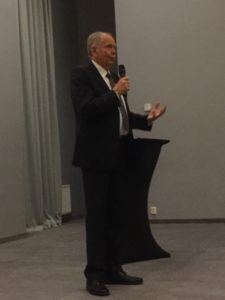 After two days filled with modern chemistry, fond memories and about 80 participants paying tribute to professor Leiv Kr. Sydnes and his many contributions to chemistry, university and society, it is easy to conclude that the symposium has been a great success. Pro-Rector Margareth Hagen set the stage in the beautiful University Aula with her inspired opening words on Tuesday, nicely followed the highly acclaimed Audun Kayser reciting four pieces of Grieg. Leiv’s first PhD graduate, professor John Sigurd Svendsen, UiT, took the audience along for a most impressive and capturing journey that combined chemistry and entrepreneurship, and from there on one inspired lecture followed after the other, until professor Magne O. Sydnes, UiS, gave the last one today, titled Chemistry in the Sydnes Laboratories.
After two days filled with modern chemistry, fond memories and about 80 participants paying tribute to professor Leiv Kr. Sydnes and his many contributions to chemistry, university and society, it is easy to conclude that the symposium has been a great success. Pro-Rector Margareth Hagen set the stage in the beautiful University Aula with her inspired opening words on Tuesday, nicely followed the highly acclaimed Audun Kayser reciting four pieces of Grieg. Leiv’s first PhD graduate, professor John Sigurd Svendsen, UiT, took the audience along for a most impressive and capturing journey that combined chemistry and entrepreneurship, and from there on one inspired lecture followed after the other, until professor Magne O. Sydnes, UiS, gave the last one today, titled Chemistry in the Sydnes Laboratories. 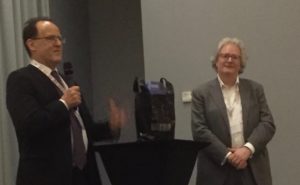 Somewhere in the middle there was a very nice evening dinner, with speeches held and presents given, by profs. Yngve Stenstrøm, Trond Vidar Hansen, the fore-mentioned pro-rector, our dean, and quite a few others. The event was very well initiated and organised, thanks due to Hans-René Bjørsvik, Bengt Erik Haug, Bjarte Holmelid, Ole Heine Kvernenes, Marit Kristin Leiren and Stig Valdernes.
Somewhere in the middle there was a very nice evening dinner, with speeches held and presents given, by profs. Yngve Stenstrøm, Trond Vidar Hansen, the fore-mentioned pro-rector, our dean, and quite a few others. The event was very well initiated and organised, thanks due to Hans-René Bjørsvik, Bengt Erik Haug, Bjarte Holmelid, Ole Heine Kvernenes, Marit Kristin Leiren and Stig Valdernes.
Det gode arbeidsmiljø – Frokostseminar 31. mai
Ansatte og ledere ved UiB ønskes velkommen til frokostseminar 31. mai.
Vernetjenesten ved UiB ønsker å skape en arena ved UiB der vi kan ta opp betydningen av arbeidsmiljø. Vi vil invitere til frokostseminarer for å snakke om arbeidsliv og arbeidsmiljø under endring og omstilling. Målgruppen er alle ansatte og ledere.
Det første frokostseminaret arrangeres torsdag 31. mai kl. 0830-1000 i nytt odontologibygg, Årstadveien 19, 1. og 2. molar. Temaet er *Fleksibel – digital – fremtidsrettet * – Hvordan tar vi vare på arbeidsmiljøet i et mer effektivt, fleksibelt og digitalt arbeidsliv? Et godt arbeidsmiljø kjennetegnes av god ledelse, medvirkning fra ansatte og tydelige organisatoriske rammer. Kompetanse, mestring og anerkjennelse gir både trygghet og trivsel. Dørene åpner kl. 0800 og frokost serveres fra kl. 0815.
Påmelding innen 23. mai her https://skjemaker.app.uib.no/view.php?id=5006704
Sterk Bergen-kontingent på NKS rådsmøte
 Norsk Kjemisk Selskap – NKS- har som formål «å virke for kjemiens fremme i samfunn, vitenskap, teknikk og undervisning, samt å representere norske kjemikere og ivareta deres faglige interesser». Verksemda blir leia av Hovudstyret, men det er Rådet som har øvste mynde. Det årlege rådsmøtet er dermed den avgjerande instansen i NKS, og for 2018 fann dette stad sist fredag. Bergen og UiB var godt representert ved Camilla Løhre samt firkløveret på biletet: Audun, Bengt Erik, Olav og Leiv Kr.
Norsk Kjemisk Selskap – NKS- har som formål «å virke for kjemiens fremme i samfunn, vitenskap, teknikk og undervisning, samt å representere norske kjemikere og ivareta deres faglige interesser». Verksemda blir leia av Hovudstyret, men det er Rådet som har øvste mynde. Det årlege rådsmøtet er dermed den avgjerande instansen i NKS, og for 2018 fann dette stad sist fredag. Bergen og UiB var godt representert ved Camilla Løhre samt firkløveret på biletet: Audun, Bengt Erik, Olav og Leiv Kr.
NKS var ei drivande kraft i markeringa av det internasjonale kjemiåret i 2011, og vi ser fram til ei tilsvarande synleggjering av kjemifaget i samband med feiringa av det internasjonale året for periodesystemet, 2019, 150 år etter at Dmitrij Mendelejev konstruerte det første periodesystemet. Vi siterer IUPAC: In proclaiming an International Year focusing on the Periodic Table of Chemical Elements and its applications, the United Nations has recognized the importance of raising global awareness of how chemistry promotes sustainable development and provides solutions to global challenges in energy, education, agriculture and health. Dette er ein lissepasning til NKS i deira arbeid for kjemiens fremme i samfunn, vitenskap, teknikk og undervisning.
June offers two important occasions to note in the calendar
June 18: HSE-day at the Chemistry dept. The event is compulsory and lasts full office hours until 15h00. Please note, you will receive invitation for a social continuation starting at 15h15. June 19: Celebrating Leiv Sydnes – chemist, educator, world citizen and in a couple of months, Emeritus Professor! Save the time-slot 12h-14h.
Successful nanoBergen meeting
 The nanoscience network in Bergen, nanoBergen, had an interesting and successful meeting at Hotel Neptun last Thursday. The interdisciplinarity of this research field was evident by the attendance and contributions to the meeting. The departments of physics and technology, biology, clinical dentistry, and chemistry from UiB were all represented. There were also representatives from Western Norway University of Applied Sciences present. From industry we had visits from the local companies EnSOL AS og Joma International AS. Additionally, we had a very interesting presentation and introduction to the “SFI Smart Ocean. Initiative for new Innovation Centre” by Jon Hellevang from GCE Subsea.
The nanoscience network in Bergen, nanoBergen, had an interesting and successful meeting at Hotel Neptun last Thursday. The interdisciplinarity of this research field was evident by the attendance and contributions to the meeting. The departments of physics and technology, biology, clinical dentistry, and chemistry from UiB were all represented. There were also representatives from Western Norway University of Applied Sciences present. From industry we had visits from the local companies EnSOL AS og Joma International AS. Additionally, we had a very interesting presentation and introduction to the “SFI Smart Ocean. Initiative for new Innovation Centre” by Jon Hellevang from GCE Subsea.
Hopefully the meeting will spark further discussions, new ideas and collaborations, and ultimately successful grant applications! Thanks to Mali HusbyRosnes for organizing the meeting! For more information regarding the nanoBergen network check out their webpage: https://nanobergen.w.uib.no/
Do you wonder…
…how Bjørn Grung found himself here? For the answer, attend the Thursday lunch seminar this week at 12.15 @Tripletten. Welcome!
Flow chemistry
Early this year, the department got new instrumentation for flow chemistry. In the lunch seminar this week, Audun will give an introduction to the new technology, in his lecture over the self-chosen topic Enabling technologies: Flow Chemistry.
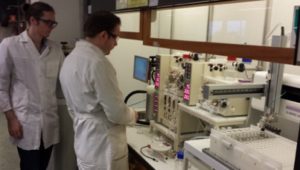
In more detail: The common laboratory glassware has in decades been the go-to tool for chemists, but it has restricted the way we conduct chemistry. New emerging technologies give the chemist improved control over reaction parameters. Flow chemistry enables new discoveries in multiple branches of chemistry. The basic concepts of flow chemistry and its advantages are presented. Resent developments in the field are highlighted
4D coordinates: Thursday Oct 5 at 12.15, at Tripletten (3069).